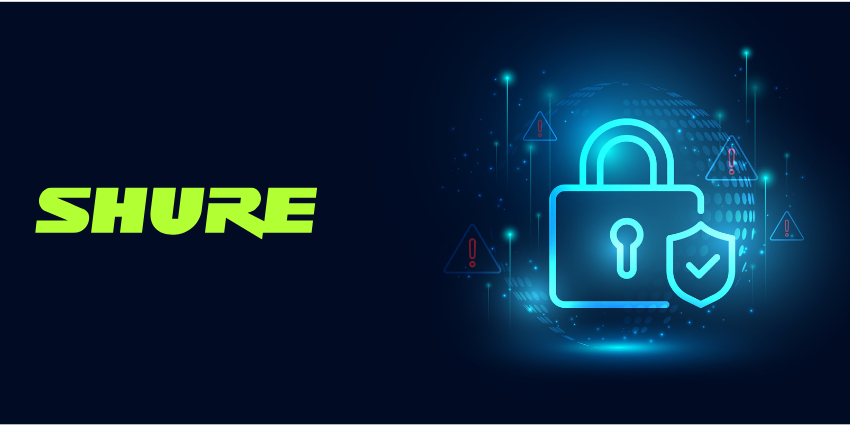Today’s AV infrastructure represents a complex network of interconnected devices that integrate deeply with corporate IT environments.
Although this has helped make meetings much more seamless, it has created new security considerations.
Unlike traditional AV setups that operated in isolation, contemporary systems connect directly to corporate networks, process sensitive communications, and often maintain persistent connections to cloud services.
Consequently, AV devices can potentially provide access to a company’s wider network and assets.
As Susy Liem, AVP Product Management, Conferencing at Shure, notes, “A secure AV product protects all transmitted, stored, and processed data from unauthorized access.”
Yet the best way to approach these concerns on a company level is to develop a holistic security plan that includes choosing an AV partner that provides solutions with a commitment to security.
The True Cost of Unmanaged AV Security
Many network-connected AV devices suffer from fundamental security deficiencies that make them difficult to integrate into security-minded enterprises.
Default password configurations represent one of the most pervasive vulnerabilities, with many vendors selling products with shared passwords that are often publicly documented online.
Unencrypted audio and video streams create additional exposure points. Such audio and video streams can be intercepted, leading to unauthorized exposure of sensitive information.
This is exacerbated by poor firmware updates. Outdated, infrequent, or unreliable firmware update mechanisms make it difficult for IT managers to keep devices up to date, which can lead to unpatched vulnerabilities in the field.
Recognizing these problems, some companies try to retroactively remedy them.
However, this piecemeal approach to security creates its own set of challenges. Christopher Meyer, Product Security and Conferencing Platform at Shure, explains that “retrofitting security after deployment often leads to gaps and inconsistencies,” highlighting why these foundational weaknesses are so difficult to address post-installation. These gaps, in turn, can create openings for a company to be hit with a significant issue.
When an AV endpoint is compromised, it can be used to gain wider entry into a company’s network. This can result in data loss or operational downtime.
Given these widespread concerns, the question becomes: how can organizations protect themselves without sacrificing the collaboration benefits that modern AV provides?
The answer lies in choosing vendors who have designed security into their products from the ground up.
Shure: Engineering Protection from the Ground Up
Shure’s approach to AV security focuses on building protection into their products from the very beginning, avoiding the common pitfalls of retrofitting security features later on.
This philosophy stems from understanding how security vulnerabilities typically develop. As Meyer explains: “Considering security during the design process helps identify and address vulnerabilities before they become deeply embedded in the architecture.”
This proactive mindset means security isn’t an afterthought but a core part of Shure’s system architecture. Throughout every stage, from initial design to deployment and ongoing updates, Shure has security at the heart of their design philosophy.
Technically, Shure layers multiple enterprise-grade protections to safeguard its devices. They start with 802.1x network access control, which restricts device access to authorized networks only, boosting both visibility and administrative control.
Equally, audio transmissions are secured with AES-256 encryption, the same standard trusted by financial institutions and government agencies for highly sensitive data.
To further protect user credentials, Shure’s Microflex ecosystem uses the Secure Remote Password (SRP) authentication protocol, ensuring passwords are never sent over the network in plain text. Sensitive information stored on the devices is also encrypted securely.
Shure’s dedication extends beyond initial production, however. Its security team regularly tests products, identifies vulnerabilities, and delivers patches through firmware updates, meaning devices remain secure long after their initial release.
Recent examples include enhancements in software versions like Designer 6.1 and IntelliMix Room 6.1, which introduced stronger authentication methods and customizable device settings, allowing precise access controls per room and user role.
Importantly, Shure achieves this high level of security without burdening the organizations that deploy their AV systems.
As Meyer highlights, “This balanced approach ensures AV products meet customers’ operational needs without compromising security.”
This seamless integration of security and usability shows that choosing secure-by-design AV solutions is no more burdensome than using unsecured ones, making it the obvious choice for organizations.
Making Security Central to AV Investment
With AV becoming a crucial enabler of business operations in today’s world of online meetings, organizations must take its security as seriously as any other networked device.
This should start with a shift in how they approach AV procurement. The traditional focus on features, price, and compatibility, while still important, should be balanced against comprehensive security evaluation.
To implement this shift in procurement thinking, Liem recommends organizations fundamentally change their vendor evaluation process: “Security should be a central consideration in the AV procurement process,” specifically by asking vendors specific questions about security features, updates, and patch policies as part of a procurement strategy.
That’s because organizations with robust AV security can confidently conduct sensitive discussions, host client meetings with proprietary information, and integrate AV systems more deeply with their digital transformation initiatives.
The question for organizations is no longer whether they can afford secure AV solutions, but what they save by adopting them.
Discover how secure-by-design AV and UC solutions from Shure can empower your teams to collaborate without compromise.







